
Die Schwalbe (English: The Swallow ) is the German chess composition society. It issues the bimonthly magazine Die Schwalbe.

Die Schwalbe (English: The Swallow ) is the German chess composition society. It issues the bimonthly magazine Die Schwalbe.
Die Schwalbe was founded on 10 February 1924 in Essen as Vereinigung von Problemfreunden zur Förderung der Aufgabenkunst (Society of problem friends for advancement of chess composition art). There had been 15 foundation fathers from the Ruhr Area lead-managed by Wilhelm Maßmann. Anton Trilling was their first president. In 1972 Die Schwalbe became a member of Deutscher Schachbund (German chess union) initiated by Gerhard Wolfgang Jensch.
Johannes Hinsken from Bottrop proposed the name of the society. The name traces back to a famous four-mover entitled Eine Schwalbe composed by Johannes Kohtz (1843–1918) and Carl Kockelkorn (1843–1914). The elderly problemists, who composed Eine Schwalbe after a hiatus of some years, published the problem with the motto "Eine Schwalbe macht noch keinen Sommer." (One swallow does not make a summer.) [1]
| a | b | c | d | e | f | g | h | ||
| 8 |  | 8 | |||||||
| 7 | 7 | ||||||||
| 6 | 6 | ||||||||
| 5 | 5 | ||||||||
| 4 | 4 | ||||||||
| 3 | 3 | ||||||||
| 2 | 2 | ||||||||
| 1 | 1 | ||||||||
| a | b | c | d | e | f | g | h | ||
The solution exclusively consists of moves by the white queen, that draws their circles like a swallow (Schwalbe). 1.Qa7? (threatens Qa1#) is refuted by Ra4!, and 1.Qh7? (threatens Qb1#) is refuted by Re4!
1.Qf7! (threatens 2.Nd3+ Kd1 3.Qb3#) Bd5
2.Qa7 (threatens Qa1#) Ra4
3.Qh7 Re4obstructs the diagonal of the bishop/ Be4obstructs the rank of the rook)
4.Qh1 mate / Qh4 mate
This problem is the earliest example in which a Grimshaw is preceded by critical moves by both Rook and Bishop.: [1] In the third move the black rook and the black bishop mutually obstruct in the point of intersection e4. This is outstanding aesthetically, because in the preceding moves both pieces only have been directed back critically over e4 (the bishop in the first, the rook in the second move). Only after that can white exploit the point of intersection e4 during the third move.
The magazine Die Schwalbe appeared the first time in July 1924. [2] Since that date it issues bimonthly. Only between 1943 and 1946 the appearance had been broken by the war. The then president of the society Wilhelm Karsch bridged that time sending all members Mitteilungen der Schwalbe (notes of the society). Die Schwalbe is worldwide recognised as a trade magazine. In the magazine chess compositions and solutions are published, composition tournaments announced and articles about chess compositions published.
Descriptive notation is a chess notation system based on abbreviated natural language. Its distinctive features are that it refers to files by the piece that occupies the back rank square in the starting position and that it describes each square two ways depending on whether it is from White or Black's point of view. It was common in English, Spanish and French chess literature until about 1980. In most other languages, the more concise algebraic notation was in use. Since 1981, FIDE no longer recognizes descriptive notation for the purposes of dispute resolution, and algebraic notation is now the accepted international standard.
In the game of chess, perpetual check is a situation in which one player can force a draw by an unending series of checks. This typically arises when the player who is checking cannot deliver checkmate, and failing to continue the series of checks gives the opponent at least a chance to win. A draw by perpetual check is no longer one of the rules of chess; however, such a situation will eventually allow a draw claim by either threefold repetition or the fifty-move rule. Players usually agree to a draw long before that, however.
A Babson task is a directmate chess problem with the following properties:
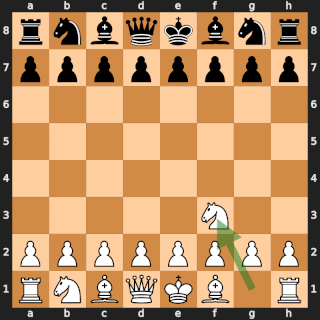
The Game of the Century is a chess game that was won by the 13-year-old future world champion Bobby Fischer against Donald Byrne in the Rosenwald Memorial Tournament at the Marshall Chess Club in New York City on October 17, 1956. In Chess Review, Hans Kmoch dubbed it "The Game of the Century" and wrote: "The following game, a stunning masterpiece of combination play performed by a boy of 13 against a formidable opponent, matches the finest on record in the history of chess prodigies."
Stalemate is a situation in chess where the player whose turn it is to move is not in check and has no legal move. Stalemate results in a draw. During the endgame, stalemate is a resource that can enable the player with the inferior position to draw the game rather than lose. In more complex positions, stalemate is much rarer, usually taking the form of a swindle that succeeds only if the superior side is inattentive. Stalemate is also a common theme in endgame studies and other chess problems.
In chess, a back-rank checkmate is a checkmate delivered by a rook or queen along a back rank in which the mated king is unable to move up the board because the king is blocked by friendly pieces on the second rank. A typical position is shown to the right.
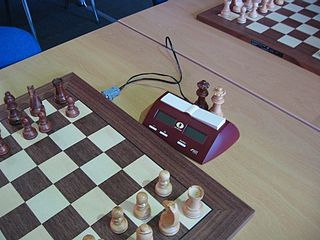
In chess, promotion is the replacement of a pawn with a new piece when the pawn is moved to its last rank. The player replaces the pawn immediately with a queen, rook, bishop, or knight of the same color. The new piece does not have to be a previously captured piece. Promotion is mandatory; the pawn cannot remain as a pawn.
In chess, a fortress is an endgame drawing technique in which the side behind in material sets up a zone of protection that the opponent cannot penetrate. This might involve keeping the enemy king out of one's position, or a zone the enemy cannot force one out of. An elementary fortress is a theoretically drawn position with reduced material in which a passive defense will maintain the draw.
Leopold Adamovich Mitrofanov was a Russian chess composer, an International Judge of Chess Composition and an International Master of Chess Composition. He was born in Leningrad and, by profession, was a chemical engineer.
The chess endgame of a queen versus pawn is usually an easy win for the side with the queen. However, if the pawn has advanced to its seventh rank it has possibilities of reaching a draw, and there are some drawn positions with the pawn on the sixth rank. This endgame arises most often from a race of pawns to promote.
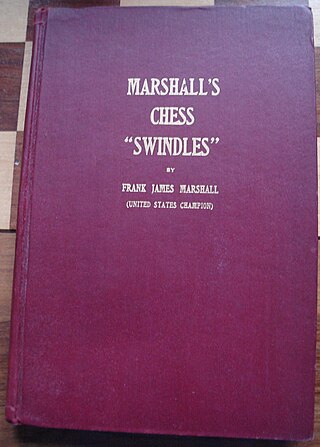
In chess, a swindle is a ruse by which players in a losing position trick their opponent and thereby achieve a win or draw instead of the expected loss. It may also refer more generally to obtaining a win or draw from a clearly losing position. I. A. Horowitz and Fred Reinfeld distinguish among "traps", "pitfalls", and "swindles". In their terminology, a "trap" refers to a situation where players go wrong through their own efforts. In a "pitfall", the beneficiary of the pitfall plays an active role, creating a situation where a plausible move by the opponent will turn out badly. A "swindle" is a pitfall adopted by a player who has a clearly lost game. Horowitz and Reinfeld observe that swindles, "though ignored in virtually all chess books", "play an enormously important role in over-the-board chess, and decide the fate of countless games".
A pawnless chess endgame is a chess endgame in which only a few pieces remain, and no pawns. The basic checkmates are types of pawnless endgames. Endgames without pawns do not occur very often in practice except for the basic checkmates of king and queen versus king, king and rook versus king, and queen versus rook. Other cases that occur occasionally are (1) a rook and minor piece versus a rook and (2) a rook versus a minor piece, especially if the minor piece is a bishop.

Johannes Kohtz was a German chess composer and together with Carl Kockelkorn one of the founders of the logical school.
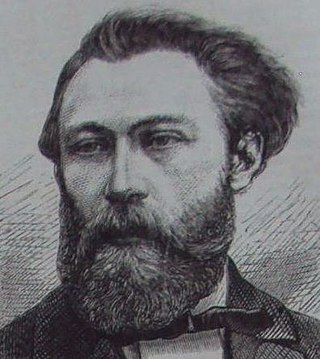
Carl Kockelkorn was a German chess composer. Together with Johannes Kohtz he founded the logical school of chess compositions.
A reflexmate is a chess problem in which white, moving first, must force black to deliver checkmate within a specified number of moves against his will – with the added condition that if either player can give checkmate, they must. If this condition applies only to Black, it is a semi-reflexmate.
The queen and pawn versus queen endgame is a chess endgame in which both sides have a queen and one side has a pawn, which one tries to promote. It is very complicated and difficult to play. Cross-checks are often used as a device to win the game by forcing the exchange of queens. It is almost always a draw if the defending king is in front of the pawn.
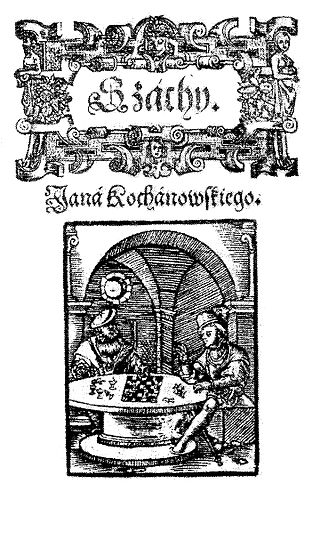
Chess is a poem written by Jan Kochanowski, first published in 1564 or 1565. Inspired by Marco Girolamo Vida's Scacchia Ludus, it is a narrative poetry work that describes a game of chess between two men, Fiedor and Borzuj, who fight for the right to marry Anna, princess of Denmark. The poem anthropomorphises the pieces, presenting the game as a battle between two armies, in a style reminiscent of battle scenes in the works of Homer and Virgil.
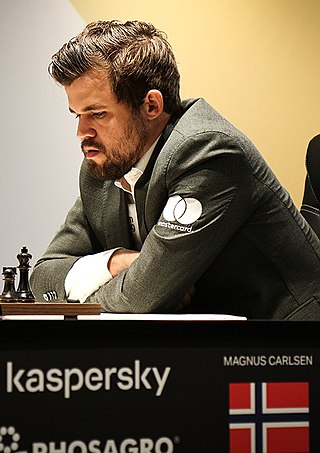
The World Chess Championship 2021 was a chess match between the reigning world champion Magnus Carlsen and the challenger Ian Nepomniachtchi to determine the World Chess Champion. It was held under the auspices of FIDE and played during Expo 2020 at Dubai Exhibition Centre in Dubai, United Arab Emirates, between 24 November and 12 December 2021. It was originally scheduled for the latter half of 2020 but was postponed until 2021 because of the COVID-19 pandemic. As a result, this is the first sporting event to be held at an international exposition since the 1904 Summer Olympics during the Louisiana Purchase Exposition in St. Louis, United States.
On 3 December 2021, the defending world champion Magnus Carlsen defeated the challenger Ian Nepomniachtchi in the sixth game of the World Chess Championship 2021 in 136 moves, which made it the longest game in the history of the World Chess Championship. The game was played in 7 hours and 45 minutes, finishing after midnight local time, to take Carlsen to a 3½–2½ lead in the best-of-14-game match.

Adolf Christian Bayersdorfer, was a German art historian and chess composer.